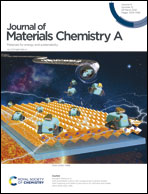Kinetic origins of the metastable zone width in the manganese oxide Pourbaix diagram†
Abstract
Pourbaix diagrams show solid–aqueous phase stability as a function of pH and redox potential and can be a valuable tool to guide the hydrothermal synthesis of transition metal oxides. However, the Pourbaix diagram is based on thermodynamics, and nucleation kinetics are not readily apparent in this framework. Here, we conduct a combined experimental and theoretical study to measure the onset of MnO2 precipitation from an MnO4−(aq) solution at various pH conditions, which we then compare against Pourbaix diagram phase boundaries. Using a combination of in situ X-ray absorption spectroscopy and X-ray wide-angle scattering, we directly observe the transformation kinetics from the tetrahedral MnO4−(aq) ion to octahedrally coordinated Mn pre-nuclei, as well as its initiation into crystalline δ′-MnO2 at various pH. The kinetics of octahedral-Mn precursor availability is observed to govern induction times of crystalline MnO2 nucleation, which results in a metastable zone width in the Mn–H2O Pourbaix diagram. These results suggest that synthesis conditions often need to be prepared far beyond the phase boundaries in a Pourbaix diagram to initiate crystallization within a reasonable timescale.



 Please wait while we load your content...
Please wait while we load your content...
